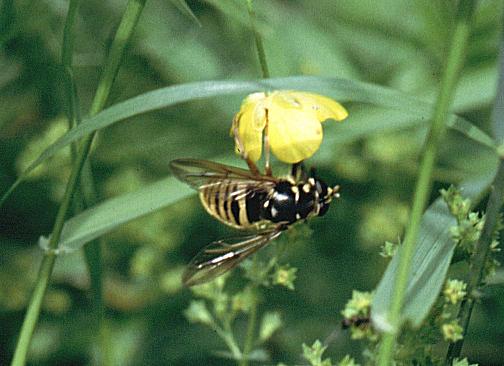

1.b. Thoracical dorsum black just before alar lobes -> 6
2.a. Tergite 3-4 and often tergite 2 with a pair of yellow stripes -> 3
2.b. Tergite 2-4 with a single yellow stripe, at the hind margin at most a small stripe of grey dust without clear margin; upper protrusion of the gonites long and thick, arched, attached to the tip. Northern Europe, Siberia. -> Temnostoma sericomyiaeforme
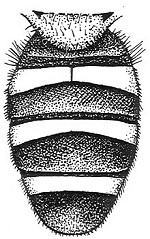
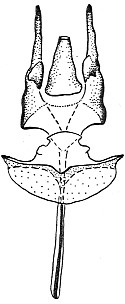

Temnostoma sericomyiaeforme. Left: thorax and abdomen of male; middle: aedeagus, gonite and apodema of male; right: tergite 8 of female (Krivosheina, 2004).
3.a. Tergite 2-4: anterior and posterior yellow stripe broadly connected at the side margin, the width of the black stripe in between 2-2.5 times smaller than the width of the anterior yellow stripe. [Male vespiforme: upper protrusion of the gonites a long slender tooth; the hind margin of the blade of the apodema of the aedeagus triangular, with virtually straight margins] -> 4
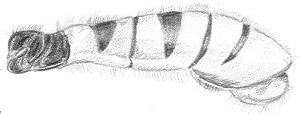
T. vespiforme, yellow stripes on each tergite broadly connected at tergite margin (Verlinden).
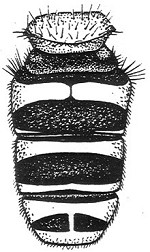
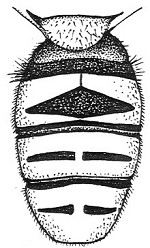
T. sibiricum, left, and T. vespiforme, right. Male thorax and abdomen (Krivosheina, 2004).
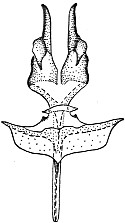
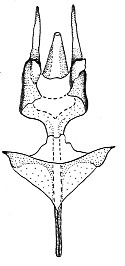
T. sibiricum, left, and T. vespiforme typical form, right. Aedeagus, gonite and apodema of male (Krivosheina, 2004).
6.a. Postalar knobs with short, adpressed to semi-erect hairs; tergite 2 with its front part constricted and margins divergent. Male: thoracic dorsum longer than wide, rectangular; tergite 2: length longer than width. Female: tergite 2: length less than 2 times its width. -> 7

Temnostoma bombylans (Verlinden).
8.a. Males and females. Tergite 2-4(-5 for females) with 2 yellow stripes. Females: width of dust spots on frons 1/6-1/2 of the undusted stripe in between -> 9
8.b. Females (males not keyed out by Krivosheina (2004), but males presumably follow this also). Tergite 2-4(-5 for females) with 1 yellow stripe in anterior part, at most traces of grey dust at the hind margin of tergite 4 and 5. Female: frons with dust spots narrow, their width 1/7 to 1/8 of the width of the undusted stripe in between. -> Temnostoma carens Gaunitz
1.a. Eyes meet over a certain distance or touch in a point; abdomen with 4 well developed segments visible. Males -> 2
1.b. Eyes widely separated; abdomen with 5 well developed segments visible. Females -> 9
2.a. Thoracic dorsum almost square; abdomen: length of tergite 2 shorter than its width; postalar knobs and scutellum with long, erect hairs; abdomen with parallel margins, tergite 2 not narrowe in front. Group apiforme and vespiforme -> 3
2.b. Thoracic dorsum elongated, rectangular; abdomen: tergite 2 longer than its width; postalar knobs and scutellum with short, adpressed hairs; abdomen: tergite 1 and front half of tergite 2 narrowed, tergite 3-4 clearly broader. Group bombylans.
3.a. Thoracic dorsum without triangular pale spots before the postalar knobs; dorsal protrusions of the hypandrium gradually narrow to the tip. Group apiforme. -> 4
3.b. Thoracic dorsum with triangular pale spots before the postalar knobs; dorsal protrusions of the hypandrium with broad lateral lobes. Group vespiforme -> 5
4.a. Pairs of pale stripes on tergite 3-4 connected at the margin of the tergite. Hind pale stripe on the 3rd tergite equal to or little wider than the front pale stripe, on the 4th tergite, the hind stripe 1.5 times wider than the front pale stripe. The middle, dark stripe on the 3rd tergite is 1.5 times, and on the 4th tergite 1.3 times the width of the front pale stripe. Bare stripe on the face in the middle 3 to 4 times narrower than in the lower part. Coxa 2-3 reddish -> Temnostoma apiforme.
4.b. Pairs of pale stripes on tergite 3-4 entirely separated, also at margin. Hind pale stripe on the 3rd tergite 2 times narrower than the front pale stripe, on the 4th tergite width of hind pale stripe equal to front pale stripe. The middle, dark stripe on the 3rd tergite 2.5-3, and on the 4th tergite 3 times the width of the front pale stripe. The bare stripe on the face in the middle 2-2.5 times narrower than in lower part. Coxa 2-3 with a black stripe apically -> Temnostoma pallidum
5.a. Tergite 2, 3 and 4 with a broad pale stripe, occasionally accompanyied by greyish dusting along the hind margin of tergite 3 and 4, which does not form a claer stripe. The upper protrusion of the gonites are long, massive and arched, attached near the tip. The bare stripe on the face in the middle 3 times narrower than in lower part. Eyes connected over a distance 1.5 to 2 times smaller than the length of the 'upper frons triangle' (??) -> Temnostoma sericomyiaeforme
5.b. Tergite (2), 3 and 4 with a clear pale stripe on the hind margin, that approaches or connects to the front pale stripe on the lateral margin of the tergite. Protrusions of the gonites different. -> 6
6.a. Front and hind pale stripes on the tergites broad and connected at the lateral margin of the tergite. The black stripe on the 3rd tergite 2 times and on the 4th tergite 2.5 times narrower than the front pale stripe on the same tergite. Upper protrusion of the gonites look like a slender long tooth. The blade of the apodema of the aedeagus triangularly extended. The dark longitudinal stripe of the face at the facial knob 2-2.5 narrower than its lower part and 4-5 times narrower than its upper part. -> Temnostoma vespiforme
6.b. Front and hind pale stripes on tergite 3 and 4 broadly separated, also at the lateral margin of the tergite, at most connected through a small pale stripe on the lateral tergite margin. The width of the middle, black stripe on tergite 3 and 4 equal to or wider than the width of the front pale stripe. Upper protrusion of the gonites relatively short. The blade of the apodema of the aedeagus broadly rounded, convex -> 7
7.a. Coxa 3 apically with pale hairs only. Eyes meet over a distance equal to the length of the 'upper frons triangle' (??) -> Temnostoma vespiforme altaicum Krivosheina ssp.n.
7.a. Coxa 3 apically with many black hairs among the pale ones. Eyes meet over a distance 1.5 times smaller than the length of the 'upper frons triangle' -> 8
8.a. The width of the middle, dark stripe on tergite 3 and 4 more than twice the width of the front pale stripe. The hind pale stripe of the 3rd tergite 2-3 times as wide as its front pale stripe. Eyes meet over a distance 1.3-1.5 times shorter than the length of the 'upper frons triangle'. -> Temnostoma sibiricum Portshinsky
8.b. The width of the middle, dark stripe on tergite 3 and 4 is 1.3-1.5 times the width of its front pale stripe. The width of the hind pale stripe on the 3rd tergite is at most 1.5 times smaller than the width of the front pale stripe. eyes meet over a distance 2.5 times shorter than the length of the 'upper frons triangle'. -> Temnostoma vespiforme tuwensis Krivisheina ssp.n.
9.a. Postalar knob with short hairs. Tergite 2 widens towards the hind margin, its length less than 2 times its width. Group bombylans.
9.a. Postalar knob with long hairs. Tergite 2 with parallel margins, its length less than almost 3 times its width. -> 10
10.a Thoracic dorsum without triangular pale spots in front of the postalar knob. The sclerotinized lateral extensions on tergite 8 long, they equal the median extension in length. Group apiforme. -> 11
10.b. thoracic dorsum with clear triangular pale spots in front of the postalar knob. The sclerotinized lateral extensions on tergite 8 short and reach only halfway the median extension. Group vespiforme -> 13
11.a. Dust spots on the frons long and broadly rounded apically, they reach the front ocellus; the width of the dust spots 2-2.5 times narrower than the undusted stripe in between. Tergite 3: hind pale stripe 2-2.5 narrower than front pale stripe, tergite 4 and 5 with front and hind pale stripe equal in width. The width of the dark middle stripe on tergite 3 and 4 almost twice the width of the front pale stripe. Coxa 3 apically darkened. Tergite 8 with the median sclerotinized extension narrowed in apical half. Tergite 9: sclerotinized extensions with a few bristles at hind margin. -> Temnostoma pallidum Sack
11.b. Dust spots on the frons short and apically pointed, they do not reach the front ocellus. The width of the dust spots 4-6 times narrower than the undusted stripe in between at the height of the lunula -> 12
12.a. Tergite 2-5 with 1 wide pale stripe and occasionally with traces of pale dust along the hind margin of tergite 4 and 5. The width of the dust spots on the frons 7-8 times narrower than the width of the longitudinal dark stripe near the front ocellus and 6 times narrower near the lunula. -> Temnostoma carens
12.b. Tergite 2-5 with two pale stripes, widening towards tergite margin. On the 3rd tergite, the hind pale stripe as wide as the front pale stripe, on tergite 4-5 the hind pale stripe wider than the front pale stripe. Frons: the width of the dust spots 4 times smaller than the longitudinal dark stripe near the lunula. Sclerotinized part of the 8th sternite with 1 rounded pale spot. Sclerotinized parts of tergite 9 with numerous setae, that reach the middle of the tergite. -> Temnostoma apiforme
13.a. Tergite 2-5 with one pale stripe. Face: the width of the bare stripe 1.5-2 times narrower than the dusted parts on the facial knob. -> Temnostoma sericomyiaeforme
13.b. Tergite 2-5 or tergite 4-5 with two pale stripes -> 14

T. sericomyiaeforme, tergite 8 of female (Krivosheina, 2004).
14.a. The hind pale stripe on tergite 2 well developed, 2-2.5 times narrower than front pale stripe. Pale stripes on tergite 3-5 widen towards tergite margin. On tergite 3, the width of the hind pale stripe equal to or somewhat smaller than the width of the front pale stripe. Frons: the dust spots reach over the front ocellus, narrowed at their tip. The middle stripe of the frons with protrusions at the border of the lunula -> Temnostoma vespiforme
14.b. The hind pale stripe of tergite 2 absent or present in the form of a narrow, medianly interrupted stripe. Pale stripes of each tergited broadly separated. On tergite 3, the width of the hind pale stripe 1.5 times narrower than the width of the front pale stripe -> 15
15.a. Tergite 3: the hind pale stripe 2-2.5 times narrower than the front pale stripe, the middle dark stripe 2.5-3 times wider than the front pale stripe. Tergite 4: the hind pale stripe 1.5 times narrower than the front pale stripe, the middle dark stripe 2 times wider than the front pale stripe. Frons dust spots reach almost to the front ocellus, without protrusion at the border of the lunula. Apex of coxa 3 with dark and pale hairs -> Temnostoma sibiricum
15.b. Tergite 3: the hind pale stripe is 1.5 times narrower than the front pale stripe, the width of the middle dark stripe equal to the width of the front pale stripe. Tergite 4: hind and front pale stripes equal in width, the middle dark stripe narrower than each pale stripe. Frons: the dust spots reach to the hind margin of the front ocellus, with 1 protrusion on the border of the lunula. Apex of coxa 3 with pale hairs only -> Temnostoma vespiforme altaicum
1.a. Ogen raken elkaar over een bepaalde afstand of raken elkaar op een punt; achterlijf met 4 goed ontwikkelde segmenten; mannetjes -> 2
1.b. Ogen breed gescheiden; achterlijf met 5 goed ontwikkelde segmenten gezien vanaf de bovenkant; vrouwtjes ->
2.a. Middenrug (vertaling: borststukrug) bijna vierkant; lengte segment 2 van achterlijf korter dan zijn breedte; postalar knobbels en schildje hebben lange rechtopstaande haren; achterlijf parallel, voorste stuk 2e segment niet ingesnoerd. Behoord tot de groep van apiforme en vespiforme -> 3
2.b. Middenrug (vertaling: borststukrug) is een beetje verlengd (vertaling: rechthoekig); de lengte van het 2e segment van het achterlijf is beduidend groter dan de breedte; postalar knobbels en schildje met korte aanliggende haren; eerste segment van achterlijf en de voorhelft van het tweede segment ingesnoerd in vergelijking met de andere segmenten, segment 3-4 zijn een stuk breder. Behoord tot groep van bombylans.
3.a. Middenrug (vertaling: borststukrug) zonder driehoekige lichte vlekken rond de postalar knobbels; dorsale uitgroeisels van het hypandrium worden geleidelijk smaller naar de top. Groep apiforme -> 4
3.b. Middenrug (vertaling: borststukrug) met duidelijke lichte driehoekige vlekken rond postalar knobbels; dorsale uitgroeisels van het hypandrium met brede zijlobben. Groep vespiforme -> 5
4.a. Paren van lichte strepen op tergite 3-4 verbonden langs de zijkant. Achterste lichte streep op het 3e tergiet is gelijk of iets breder dan de voorste lichte streep in het midden. Op het 4e tergiet is het anderhalf keer breder. De middelste donkere streep van het 3e tergiet is anderhalf keer, en op het 4e tergiet 1,3 maal, breder dan de voorste lichte streep. Kale streep van het gezicht is in het midden 3.0-4.0 maal smaller dan (vert. dan de streep eronder). Middelste en achterste heupen zijn rossig. T. apiforme
4.b. Paren van lichte strepen op tergiet 3-4 gescheiden; achterste lichte streep op het 3e tergiet is twee maal smaller dan de voorste en op het 4e tergiet gelijk aan de voorste. De middelste donkere streep van het derde tergiet is 2.5-3.0 maal breder, van het 4e is het 3 maal breder , dan de voorste lichte streep. De kale middenstreep van het gezicht is in het midden 2.0-2.5 maal smaller dan de streep eronder. Middelste en achterste heupen hebben beneden een zwarte strook. T. pallidum
5.a. tweede tot en met vierde tergiet hebben een brede lichte streep, soms langs de achterrand van tergiet 3-4 grijsachtig bestuiving, vormt een smalle streep zonder duidelijke grenzen. De bovenste uitgroeisel van gonieten (in russisch: gonit) zijn lang, massief boogvormig/gebogen vastgemaakt onmiddellijk bij de top. De breedte van kale streep in het midden van het gezicht (ter hoogte van de middenknobbel) is driemaal kleiner dan de bestoven streep/streep eronder, de lengte van de streep die de twee ogen verbindt is anderhalf to twee maal kleiner dan de lengte van de bovenste voorhoofdsdriehoek. T. sericomyiaeforme
5.b. tergiet 2-4 of 3-4 naast de voorrand met een duidelijke lichte streep op de achterste rand, die de voorste streep aan de zijkant nadert. Uitgroeisels van de gonieten van verschillende vormen. -> 6
6.a. voorste en achterste lichte strepen van het achterlijf zijn breed en verbonden aan de zijkant; de breedte van de zwarte middenstreep op het 3e tergiet is twee maal smaller dan de voorste lichte streep, echter op het 4de tergiet is het 2.5 maal. Bovenste uitgroeisel van de gonieten zien eruit als een smalle lange tand. Het overdwarse blad van apodema van de aedeagus is duidelijk uitgerekt aan de achterkant. De donkere middenstreep van het gezicht is ter hoogte van de middenknobbel 2-2.5 maal smaller dan de streep daaronder en 4-5 maal smaller dan die erboven. T. vespiforme
6.b. voorste en achterste lichte strepen van het 3-4 tergiet zijn breed gescheiden (lett. wijd uitelkaar gezet) of verenigt door een smal licht strookje, onmiddellijk aan de rand van het tergiet. De breedte van de zwarte strook in het midden vna de 3e tot 4e tergieten is niet kleiner of beduidend breder dan de voorste lichte streep. Achterste aangroeisel van de gonieten is betrekkelijk kort. Het overdwarse blad van de apodema van de aedeagus is breed afgerond van achteren. -> 7
7.a. de achterste heupen hebben onderaan lichte haartjes in alle richtingen; de lengte van het voorhoofdstreepje (vert. waar ogen raken) benaderd de lengte van de topvoorhoofdsdriehoek (vert. vertex). T. vespiforme altaicum
7.a. de achterste heupen hebben onderaan in iedergeval in het gebied van de top langs lichte en vele zwarte haartjes. De lengte van het voorhoofdsstreepje is anderhalf maal minder dan de lengte van bovenste voorhoofdsdriehoek -> 8
8.a. de breedte van de middelste donkere streep van tergiet 3-4 is meer dan twee maal zo breed als de voorste lichte streep. De achterste lichte streep van het derde tergiet is 2-3 maal smaller dan de voorste. De lengte van de voorhoofdsstreep is 1.3-1.5 minder dan de lengte van de bovenste voorhoofdsdriehoek. T. sibiricum
8.b. de breedte van de middelste donkere streep van tergiet 3-4 is 1.3-1.5 zo breed als de breedte van de voorste lichte streep. De breedte van de achterste lichte streep van het 3e tergiet is hoogstens 1.5 maal kleiner dan de breedte van de voorste lichte streep. De lengte van de voorhoofdstreep is 2.5 maal kleiner dan de lengte vna de bovenste voorhoofdsdriehoek. T. vespiforme tuwensis
9.a. postalar knobbel met korte haartjes. Tweede tergiet verbreed zich in de richting van de achterste rand, zijn lengte is minder dan 2 maal de breedte. Groep bombylans
9.a. postalar knobbel met lange haren. Tergiet 2 met parallele zijden, zijn lengte is bijna 3 maal minder dan zijn breedte. ->
10.a borststuk zonder driehoekige vlekken voor de postalar knobbel. de gesclerotiseerde uitsteeksels van tergiet 8 zijn lang, gaan bijna tot de top van de middelste uitsteeksel. Groep apiforme -> 11
10.b. borststuk met duidelijke driehoekige lichte vlekken voor de postalar knobbel. De gesclerotiseerde uitsteeksels van tergiet 8 zijn korter en gaan slechts tot het midden van de middelste uitsteeksel. Groep vespiforme -> 13
11.a. bestoven strepen op het voorhoofd zijn lang, ze gaan bijna tot het middelste oog en zijn breed afgerond aan de bovenhant; de breedte van bestoven strepen is 2-2.5 kleiner dan de breedte van de middelste kale streep van het voorhoofd. Tergiet 3: achterste lichte streep is 2-2.5 maal kleiner dan de voorste, op tergite 4-5 zijn de strepen vrijwel gelijk. De donkere middenstreep op tergiet 3-4 zijn bijna twee maal de breedte van de voorste lichte streep. De achterste heupen zijn verdonkerd iig vanaf de onderkant. De gesclerotiseerde blad van sterniet 8 met de middelste vlek versmald in het achterste deel . de geslerotiseerde blaadjes van het 9de tergiet met enkele borstels aan de achterste rand. T. pallidum
11.b. bestoven strepen op het voorhoofd betrekkelijk kort en lopen aan de top spits toe en bereiken nauwelijks de hoogte van het middelste oog. De breedte van de bestoven streep ter hoogte van de lunula is 4-6 maal kleiner dan de breedte van de middelste donkere streep. Poten rossig. -> 12
12.a. tergiet 2-5 met 1 brede lichte streep en soms met sporen van lichte bestuiving aan de achterrand van tergiet 4-5. de breedte van de bestoven strepen op het voorhoofd in de buurt van het middelste oog is 7-8 maal kleiner dan de breedte van de middelste donkere streep en 6 maal ter hoogte van de lunula. T.carens
12.b. tergiet 2-5 met twee lichte strepen, bovendien de strepen op tergiet 3-5 breed uitlopend naar de zijkant toe. De achterste lichte streep op het derde tergiet is gelijk of hoogstens een beetje smaller dan de voorste, op tergiet 4-5 is de achterste streep breder dan de voorste. De breedte van de bestoven stepen op het voorhoofd ter hoogte vn de lunula is 4 maal kleiner dan de middelste donkere streep. Gesclerotiseerd deel van de 8ste sterniet met 1 afgeronde lichte vlek. Gesclerotiseerde bladen van het 9de tergiet met talrijke korte dorentjes, die gaan bijna tot het midden. T. apiforme
13.a. tergiet 2-5 met 1 brede lichte streep in het middelste gedeelte. de breedte van de middelste kale streep van het gezicht in het middelste gedeelte (ter hoogte van de middenknobbel) is 1.5-2 maal smaller dan de bestoven streep. -> T.sericomyiaeforme
13.b. tergiet 2-5 of 4-5 met twee lichte strepen -> 14
14.a. de achterste lichte streep tergiet 2 is goed ontwikkeld, is 2-2.5 maal smaller dan de voorste. Strepen van tergiet 3-5 zijn breed uitlopend langs de zijrand. De achterste streep van het derde tergiet is gelijk aan of iets smaller dan de voorste. De bestoven strepen van het voorhoofd gaan tot aan de achterste rand van het middelste oog, versmald aan de top van de kegelvormig (vert. ocellenheuvel). De middelste streep van het voorhoofd met uitsteeksels aan de grens met de lunula. -> T. vespiforme
14.b. de achterste lichte streep van het tweede tergiet ofwel afwezig, ofwel in de vorm van een smalle in het midden onderbroken streep. Lichte strepen op tergieten aan de zijkant breed gescheiden. Achterste streep van het derde tergiet minstens 1.5 maal smaller de voorste. -> 15
15.a. de achterste lichte streep van tergiet 3 is 2-2.5 maal smaller dan de voorste, maar de zwarte streep is 2.5-3 maal breder dan de voorste lichte streep. Op het 4de tergiet is de achterste lichte streep 1.5 maal smaller dan de voorste, maar de middelste donkere streep is 2 maal breder dan de voorste. Bestoven strepen van het voorhoofd gaan bijna tot aan de zijogen, zonder uitsteeksel aan de rand met de lunula. Top van de achterste heupen op ventrale zijde met donkere en lichte haartjes -> T. sibiricum
15.b. de achterste lichte streep van het 3de tergiet is anderhalf maal smaller dan de voorste, maar de donkere middenstreep is qua breedte gelijk aan de voorste. Op het 4de tergiet zijn de lichte strepen even breed, maar de donkere een klein beetje smaller. De bestoven strepen van het voorhoofd gaan tot aan de achterste rand van het middelste oog, met 1 uitsteeksel aan de rand van de lunula. Achterste heupen beneden met lichte haartjes -> T. vespiforme altaicum.
Derksen, W. (1941) Die Succession der pterygoten Insekten im abgestorben Buchenholz. Z.Morph.Okol.der Tiere, 37: 683 - 734.
Goot, V. S. van der, 1981. De zweefvliegen van Noordwest-Europa en Europees Rusland, in het bijzonder de Benelux. - Bibl. K. Ned. Natuurh. Veren. 32: 1-274.
Krivosheina, N.P. 2004. Morphology of the species of the genus Temnostoma from apiforme and vespiforme groups, 2. Zoolichesky Zhurnal, 83: 75-92. (In Russian)
Speight, M.C.D. 2004. Species accounts of European Syrphidae (Diptera) 2004. In: Speight, M.C.D., Castella, E., Sarthou, J.-P. and Monteil, C. (eds.) Syrph the Net, the database of European Syrphidae, vol. 44, 237 pp., Syrph the Net publications, Dublin.
Torp, E., 1994. Danmarks Svirrefluer (Diptera: Syrphidae). Danmarks Dyreliv, Bind 6: 1-490. Apollo Books, Stenstrup.
Verlinden L., 1991. Zweefvliegen (Syrphidae). Fauna van België. Koninklijk Belgisch Instituut voor Natuurwetenschappen 39: 1-298, Brussel.
Last updated 24.1.2008